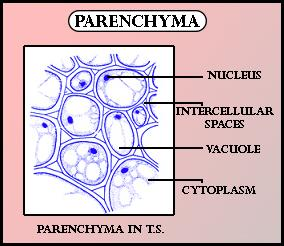
Parenchyma cells are
(a)Relatively unspecified and thin-walled
(b)Thick-walled and specialized
(c)Lignified
(d)None of these
Answer
558.3k+ views
Hint: Parenchyma cells are simple permanent tissues which make a major part of the ground tissues in plants and are embedded in the vascular tissues. It is composed of simple, living, and undifferentiated cells that perform various functions.
Complete answer:
Parenchyma cells are relatively unspecified and thin-walled. It is a group of functional substances present in the animal organs and is structured as a tumor. It is a functional part of an organ and in contrast to the stroma, it refers to the structural tissue of organs which are the connective tissues. It is present in different organs such as lungs, liver, Kidney, and tumors. It is present in the brain which is the functional tissue in the brain made up of two types of brain cells which are neurons and glial cells. A loss of cognitive ability happens due to the damage or trauma in the brain parenchyma which results in death in severe cases. Intraparenchymal hemorrhage is due to the bleeding into the parenchyma. substances outside the long of the circulatory systems which are involved with the gaseous exchanges with the involvement of pulmonary alveolar and respiratory bronchioles are due to the lung parenchyma.
Additional information:
The parenchyma of the kidney which is known as the renal parenchyma is divided into two structures which include the outer renal cortex and the inner renal medulla. They take the shape of 17 to 18 cone-shaped renal lobes and contain a renal cortex which is surrounded by a portion of medulla known as a renal pyramid. The tumor parenchyma consists of a solid tumor which is the distinct compartment of a solid tumor and is made up of neoplastic cells. It is essential for nutritional support and waste removal as many types of tumors i.e. clusters of parenchyma cells are separated through a basal lamina which sometimes can be incomplete.
So, the correct answer is 'Relatively unspecified and thin-walled'.

Note: Robert Hooke discovered parenchyma cells in the 17th century. They help in making the chloroplast and at present in the outer layers known as the cortex and the innermost layer is known as the pith. It helps in forming the soft tissues of fruits.
Complete answer:
Parenchyma cells are relatively unspecified and thin-walled. It is a group of functional substances present in the animal organs and is structured as a tumor. It is a functional part of an organ and in contrast to the stroma, it refers to the structural tissue of organs which are the connective tissues. It is present in different organs such as lungs, liver, Kidney, and tumors. It is present in the brain which is the functional tissue in the brain made up of two types of brain cells which are neurons and glial cells. A loss of cognitive ability happens due to the damage or trauma in the brain parenchyma which results in death in severe cases. Intraparenchymal hemorrhage is due to the bleeding into the parenchyma. substances outside the long of the circulatory systems which are involved with the gaseous exchanges with the involvement of pulmonary alveolar and respiratory bronchioles are due to the lung parenchyma.
Additional information:
The parenchyma of the kidney which is known as the renal parenchyma is divided into two structures which include the outer renal cortex and the inner renal medulla. They take the shape of 17 to 18 cone-shaped renal lobes and contain a renal cortex which is surrounded by a portion of medulla known as a renal pyramid. The tumor parenchyma consists of a solid tumor which is the distinct compartment of a solid tumor and is made up of neoplastic cells. It is essential for nutritional support and waste removal as many types of tumors i.e. clusters of parenchyma cells are separated through a basal lamina which sometimes can be incomplete.
So, the correct answer is 'Relatively unspecified and thin-walled'.

Note: Robert Hooke discovered parenchyma cells in the 17th century. They help in making the chloroplast and at present in the outer layers known as the cortex and the innermost layer is known as the pith. It helps in forming the soft tissues of fruits.
Recently Updated Pages
Why are manures considered better than fertilizers class 11 biology CBSE

Find the coordinates of the midpoint of the line segment class 11 maths CBSE

Distinguish between static friction limiting friction class 11 physics CBSE

The Chairman of the constituent Assembly was A Jawaharlal class 11 social science CBSE

The first National Commission on Labour NCL submitted class 11 social science CBSE

Number of all subshell of n + l 7 is A 4 B 5 C 6 D class 11 chemistry CBSE

Trending doubts
Differentiate between an exothermic and an endothermic class 11 chemistry CBSE

10 examples of friction in our daily life

One Metric ton is equal to kg A 10000 B 1000 C 100 class 11 physics CBSE

Difference Between Prokaryotic Cells and Eukaryotic Cells

1 Quintal is equal to a 110 kg b 10 kg c 100kg d 1000 class 11 physics CBSE

State the laws of reflection of light




